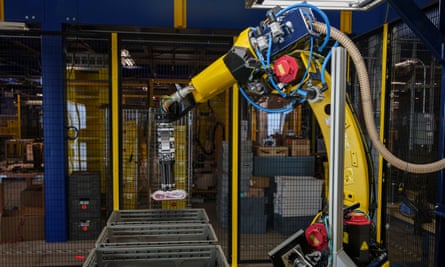
Trapped in a metal cage in a corner of a 350,000 sq ft Amazon warehouse outside Boston last week a lonely yellow robot arm sorted through packages, preparing items to be shipped out to customers who demand ever-faster delivery. Soon it will be joined by others in a development that could mean the end of thousands of jobs and, Amazon argues, the creation of thousands of others.
As the robot worked, a screen displayed its progress. It carefully packed a tub of protein powder, next came a box of napkin rings then … a tube of hemorrhoid cream. As 100 journalists from around the world snapped pictures, someone switched the screen to hide the cream.
One day soon the robot, called Sparrow, could do the work of the hundreds of thousands of people that Amazon now employs to sort the 13m packages it delivers each year. Using computer vision and artificial intelligence Amazon says Sparrow can already identify around 65% of its product inventory, tell if an item is damaged and discard it, and adjust its suction cup “hand” to handle different objects – all jobs currently done by human hands. As it learns, it gets better by the day.
Sparrow, which will likely start rolling out next year, was just one of the new army of robots on display for the first time at Amazon’s “Delivering the Future” conference last Thursday. Other innovations included an autonomous green robot called Proteus – a giant Roomba look-a-like capable of shifting heavy loads around cavernous warehouses. The company also showed off its latest drone which it hopes will allow the company to deliver 500m packages by air by the end of the decade. Another corner of Amazon’s BOS27 warehouse had been kitted out with fake grass, fake house fronts complete with welcome mats, and a giant electric-powered delivery van fitted with tech to inform drivers about the best routes and give “coaching” for better driving. Behind a white picket fence, a drone sat on the lawn, an image of how Amazon believes millions of its customers will one day receive their orders.
The 2020s will be the “age of applied robotics”, said Tye Brady, chief technologist at Amazon Robotics. “Robots will be doing meaningful tasks and extending human capability. I feel like it’s taken 50 years to get here. It’s exciting!”
In recent years Amazon has become one of the world’s largest private employers, with a payroll of more than 1.6 million as of 2021. That growth has not come without pain. Amazon is fighting tooth and nail to stop US warehouse workers angered by low wages and relentless pressure from forming unions and Wall Street has been critical of its perceived over-hiring. Robot packers, robot movers and robot deliveries could be an answer to those issues.
Brady disagrees. People have predicted that robots will destroy the labour market for decades. As far back as 1933 economist John Maynard Keynes prophesied widespread technological unemployment was coming “due to our discovery of means of economizing the use of labour outrunning the pace at which we can find new uses for labour”.
“I just don’t see that at all,” said Brady. “We made our first serious investment in robotics over 10 years ago and in those 10 years we created more than a million jobs.” More robots will boost the efficiency of warehouses meaning they can store more goods, Amazon will sell more stuff and more people will be needed to make sure everything runs smoothly, he said.
“The need for people to solve problems and use common sense will always be there,” he said. “We are nowhere near that with robotics. It’s not even close. We have millions of years of evolution for the human brain that’s powered off 20 watts and a banana, that’s incredible.”

Brady may be right on job numbers. A recent report from the US government’s Bureau of Labor Statistics said there was “little support” for the idea that the new era of smart machines would lead to job destruction. Economists even have a term for it – the “lump of labor” fallacy. Innovation may destroy occupations but there is no fixed number of jobs and new ones take their place. Warehouse jobs, for example, replaced retail jobs as online shopping decimated shopping malls.
But all this change isn’t necessarily good for workers. In a paper for the University of Berkley’s Labor Center, Beth Gutelius and Nik Theodore also concluded that tech innovations at warehouses were unlikely to cost significant job losses. But, they argued, employers “may use technology in ways that decrease the skill requirements of jobs in order to reduce training times and turnover costs. This could create adverse effects on workers, such as wage stagnation and job insecurity.”
Such arguments are unlikely to slow Amazon’s robot revolution. The company is the largest manufacturer of industrial robots in the world. Its Boston facilities already produce 330,000 robots a year. And all to ensure ever faster delivery of toothpaste – or hemorrhoid cream. And that is what people want, said Brady: “We will react and we will obsess about what the customer wants and if they want their toothpaste faster, we will help them get their toothpaste faster,” he said.



